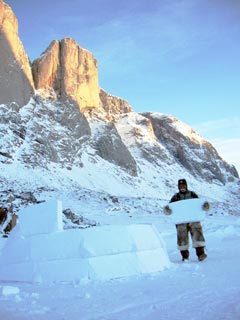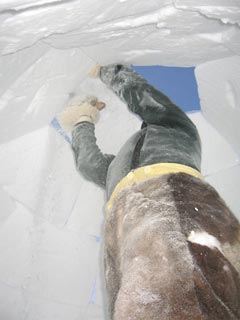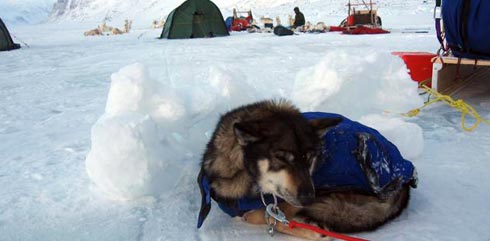 Coordinates: 67.00.571 N, 64.39.964 W
Coordinates: 67.00.571 N, 64.39.964 W
Distance Traveled: 13 mi/ 20.9 km
Wind: 5 MPH / 8 KPH
Barometric Pressure: 1048 hPa
Cloud Cover: Clear with a couple of lenticular clouds and alto cirrus clouds in late afternoon
Sunrise: 6:12 a.m.
Sunset: 6:41 p.m.
I was cutting ice chunks with an axe to weigh down the snow flaps on our tent when I looked up to see Simon cutting large snow blocks out of a snowdrift with a saw. I asked him what he was doing and he replied, “Building an igloo.”
 Coordinates: 67.00.571 N, 64.39.964 W
Coordinates: 67.00.571 N, 64.39.964 W
Distance Traveled: 13 mi/ 20.9 km
Wind: 5 MPH / 8 KPH
Barometric Pressure: 1048 hPa
Cloud Cover: Clear with a couple of lenticular clouds and alto cirrus clouds in late afternoon
Sunrise: 6:12 a.m.
Sunset: 6:41 p.m.
I was cutting ice chunks with an axe to weigh down the snow flaps on our tent when I looked up to see Simon cutting large snow blocks out of a snowdrift with a saw. I asked him what he was doing and he replied, “Building an igloo.”
 This would be the first time on this trip anyone had built an igloo, so I was curious and ready to help. In between taking photos, I carried blocks of snow over to the steadily growing igloo and passed them over the wall to Simon. Simon would quickly cut them to size with his snow knife and expertly fit them into place. He was so speedy that I barely had time to run back to grab another block before he was finished with the previous one.
This would be the first time on this trip anyone had built an igloo, so I was curious and ready to help. In between taking photos, I carried blocks of snow over to the steadily growing igloo and passed them over the wall to Simon. Simon would quickly cut them to size with his snow knife and expertly fit them into place. He was so speedy that I barely had time to run back to grab another block before he was finished with the previous one.
At one point we had used all of the blocks Simon had cut. Simon was still busy shaping the most recent block. I thought I would try my hand at cutting a snow block out of the drift. It was not nearly as easy as Simon had made it look, I soon discovered. The block I cut was not quite the same shape and size. Simon came over to look and we both had a good laugh. Simon quickly cut another stack of blocks and we were back to work on the igloo in no time.
The base of the igloo was large enough that two people could sleep comfortably on its floor with a stove for warmth between them. The ceiling was high enough for a person to stand inside. The door was just big enough for a person to wriggle out, but small enough to keep the cold wind from coming in.
I thought how cozy the igloo would be–much more so, I imagined, than our thin-walled nylon tents. Snow is a good insulator because of all the air space in it; just like the fiberglass insulation in modern homes.
 I also thought about all the Arctic animals that make their own snow dens so they can be comfortable in these extreme weather conditions. I thought about the polar bears and cubs in their dens, the voles in their snow tunnels and the seals and pups in their snow dens on top of the sea ice. Without snow for shelter, life would indeed be difficult with the Arctic winds and sub-zero temperatures.
I also thought about all the Arctic animals that make their own snow dens so they can be comfortable in these extreme weather conditions. I thought about the polar bears and cubs in their dens, the voles in their snow tunnels and the seals and pups in their snow dens on top of the sea ice. Without snow for shelter, life would indeed be difficult with the Arctic winds and sub-zero temperatures.
I have heard reports of poor snow conditions leading to collapses in certain local populations of voles. These voles are a food source for Arctic fox and other animals. If there are not enough voles, then the fox populations decrease as well.
Now that I have had a chance to experience the bitter cold and the sometimes unrelenting winds of the Arctic, I can begin to have an appreciation for the value of a good shelter. I can begin to understand the necessity of good snow for the animals who make the Arctic home.
When Simon and I finished building the igloo I cut a few more pieces of ice to make a wind-break for Frank, one of our short-haired lead dogs, just incase the wind picked up in the night.
Elizabeth





